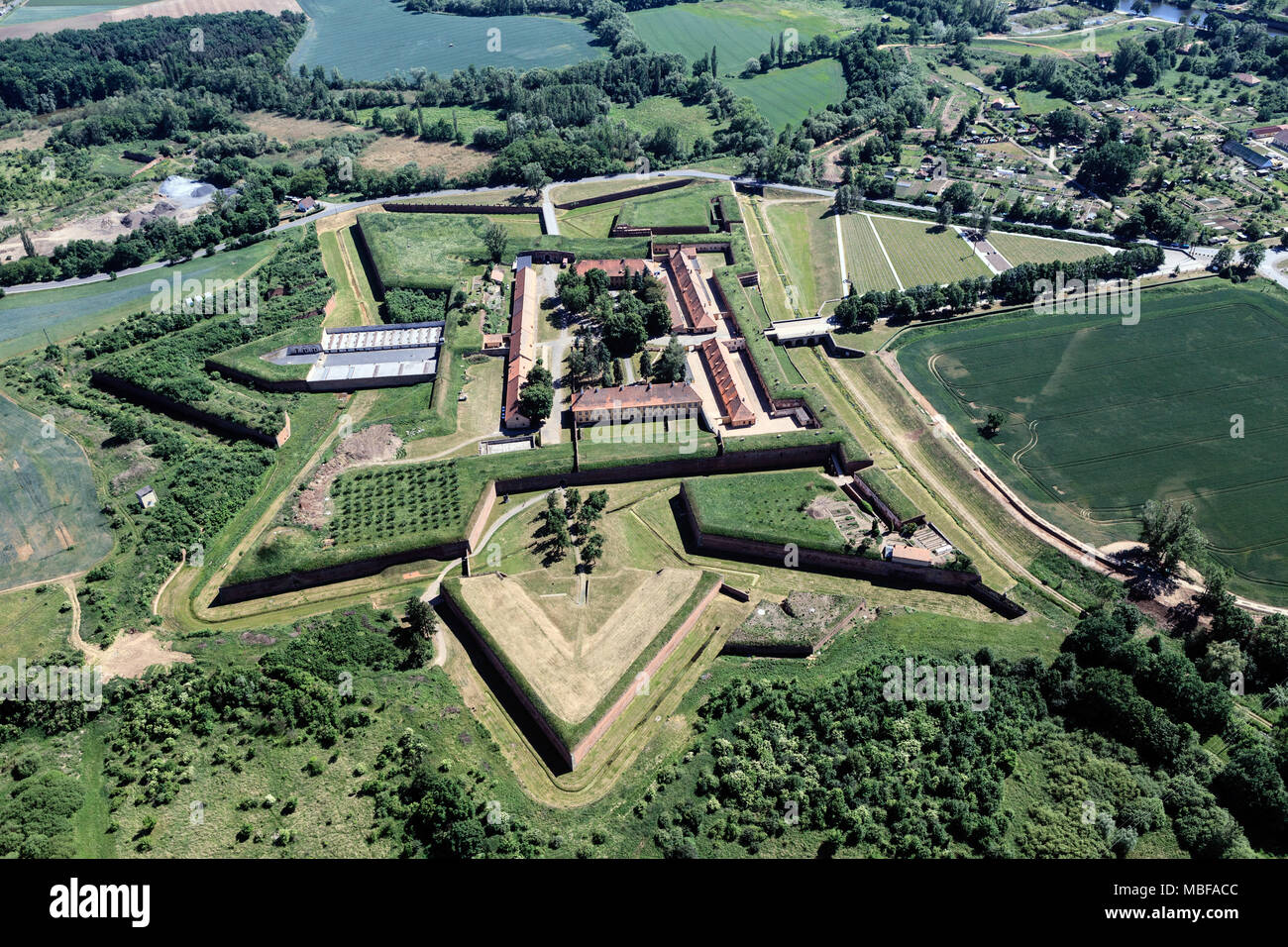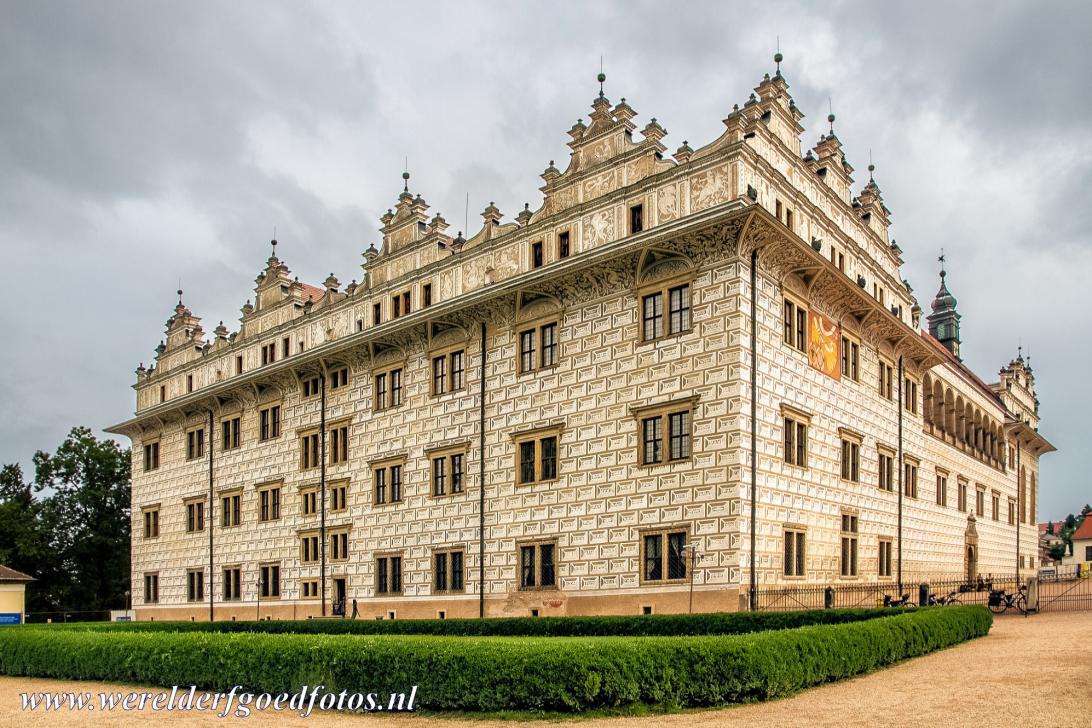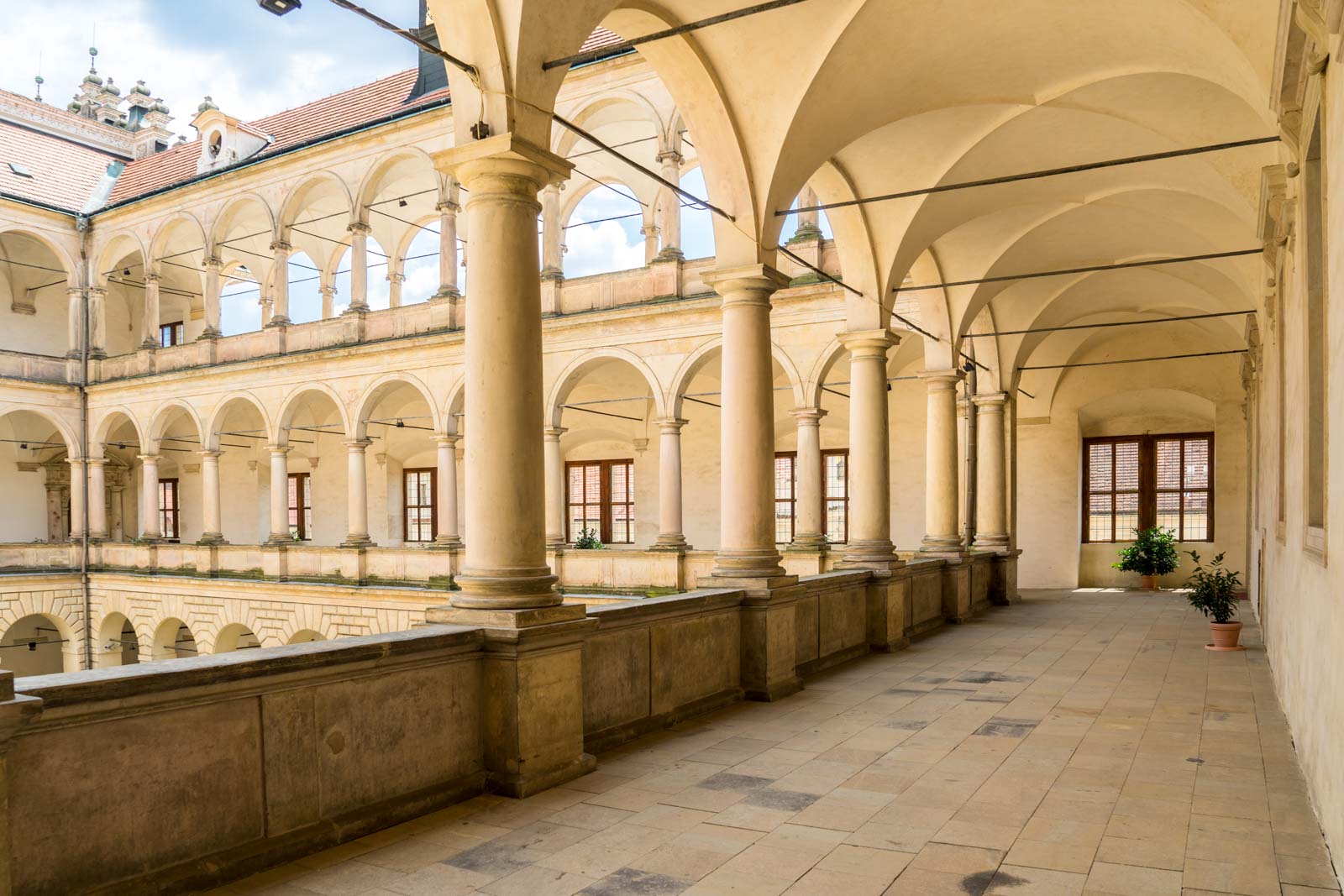Czechia – Highlands (Hr. Kralove, Liberec, Pardubice, Ústí nad Labem) September 27-28, 2019
The Fortress of Terezín. A tentative WHS (06/07/2001), this is a vast military complex with a perimeter of over 12 miles (20 kilometers), guards the confluence of the Elbe and Eger rivers in the northwest Czech Republic. Terezin was constructed between 1780 and 1790 at the order of Hapsburg Emperor Joseph II. General Karl Clemens Pellegrini designed the baroque fortress town and surrounded it with bastion-type fortifications. Terezin has three major sections: the main fortress, a smaller fortress, and the brick entrenchments on either side. Named for Empress Maria Teresa, it watched over the route between Prague and Dresden. In the mid-20th century, Terezin was given a new, ugly role in wartime affairs, when it was used as a Jewish ghetto and deportation base by the Nazis. During the past few decades, small-scale efforts have been made to conserve the site: the façade of the small fortress was partially repaired, as was the fortress church. However, a disastrous flood in August 2002 destabilized much of the structure and introduced water damage and biodegradation to Terezin’s list of threats.
Terezin Fortress. Theresienstadt Concentration Camp. In the Dark Side series, this was a hybrid concentration camp and ghetto established by the SS during World War II in the fortress town Terezín, in which tens of thousands of Jews were killed. Theresienstadt served two main purposes: it was simultaneously a waystation to the extermination camps, and a “retirement settlement” for elderly and prominent Jews to mislead their communities about the Final Solution. Its conditions were deliberately engineered to hasten the death of its prisoners, and the ghetto also served a propaganda role. Unlike other ghettos, the exploitation of forced labor was not economically significant.
The ghetto was established by a transport of Czech Jews in November 1941. The first German and Austrian Jews arrived in June 1942; Dutch and Danish Jews came beginning in 1943 and prisoners of a wide variety of nationalities were sent to Theresienstadt in the last months of the war. About 33,000 people died at Theresienstadt, mostly from malnutrition and disease. More than 88,000 people were held there for months or years before being deported to extermination camps and other killing sites; the Jewish self-administration’s role in choosing those to be deported has attracted significant controversy. Including 4,000 of the deportees who survived, the total number of survivors was around 23,000.
Theresienstadt was known for its relatively rich cultural life, including concerts, lectures, and clandestine education for children. The fact that it was governed by a Jewish self-administration as well as the large number of “prominent” Jews imprisoned there facilitated the flourishing of cultural life. This spiritual legacy has attracted the attention of scholars and sparked interest in the ghetto. In the postwar period, a few of the SS perpetrators and Czech guards were put on trial, but the ghetto was generally forgotten by the Soviet authorities. The Terezín Ghetto Museum is visited by 250,000 people each year.
In the “small fortress”, it is fronted by a large cemetery with both a Christian cross and a Star of David. The museum tells the usual story of starvation and death. 100
Mountain-top Hotel and Television Transmitter Ještěd. A tentative WHS (29/05/2007), this was built in 1976. The 23-room hotel has always been part of the building (rates 1900-4400 with 800 supplement). It was tortuous network of roads to get here with the last many switchbacks to the top of this “pimple” of a summit at 1012m elevation. It is a fantastic round building with the ground floor services, 2nd floor a walk-around corridor enclosed in glass but quite airy, the hotel lobby and buffet, 3rd floor a lovely restaurant and bar all windows. Above that are two floors of the rooms all with smaller windows. It then rises to a spire of a cone with the telecommunications equipment.
Outside is a small cobble parking area (€2) and a large terrace. Advertised as “above the clouds, today was cold, windy and completely socked in with view of about 50m.

LIBEREC (pop 150,000). On the Lusatian Neisse and surrounded by the Jizera Mountains and Ještěd-Kozákov Ridge, it is the fifth-largest city in the Czech Republic. Liberec was once home to a thriving textile industry and hence nicknamed the “Manchester of Bohemia”. For many Czechs, Liberec is mostly associated with the city’s dominant Ještěd Tower.
Český ráj (Czech Paradise) Rock Cities. A tentative WHS (19/01/2001), this is a hard place to find, but the “rock cities” refers to the Hruboskalsko, one of the best-known rock formations characterised by impressive towers reaching up to 55 m and steep canyons. Because of relatively low resistance of the sandstone it has great shapes and forms and is a popular destination for climbers.
The trail leading along the top parts is called the Zlatá Stezka Českého ráje and it connects numerous lookout points, such as the Mariánská Vyhlídka, Vyhlídka Na Kapelu, Vyhlídka U Lvíčka, Hlavatice Lookout Tower, etc. Under the Mariánská lookout point, there is a symbolic climbers’ cemetery.
Cultural landscape of the stud farm at Kladruby and Labem. A tentative WHS (29/05/2007), this is a breeding farm for the Kladruber horse, the oldest Czech horse breed and one of the world’s oldest horse breeds. The main breeding centre is in National Stud Farm Kladruby nad Labem where Kladrubers have been bred for more than 400 years. Kladrubers have always been bred to be a galakarossier – a heavy type of carriage horse for the court of the House of Habsburg. The Kladruber breed is almost 400 years old, yet is remarkably rare (492 mares as of January, 2011. Kladruby stud was founded in 1579 by Rudolf II as an Imperial stud, at the Pernstein stables. The breed was based on imported Spanish (such as the Andalusian) and Italian horses, crossed with Neapolitan, Danish, Holstein, Irish, and Oldenburg blood, in addition to the heavy Czech breeds. The animal was first developed to be a galakarosier; a heavy type of carriage horse used to pull the imperial coach, usually in a four- or six-in-hand, at ceremonies and funerals. It originally came in a variety of colors, including palomino and appaloosa, although today the breed is strictly gray or black, due to a breeding program requiring 18 “white” (i.e. fully mature grays) and 18 black stallions for various ceremonies of the court.
The black and white Kladrubers have several differences due to their breeding. The white is finer, more Thoroughbredish in type, and usually taller than the black. The black has more Neapolitan blood, and thus is heavier, has a shorter croup, a different head and neck, and a more “Nordic” look to it.
This is visited in several 45-minute guided tours, quite expensive to see them all: the castle (12 rooms, the house of Franz Joseph and his wife Sisi, includes the small church 135), Stables (follow the newborn to stud mare and breeding stallion 180), Carriage House and harness room 135), Foresters House 65), and Observation Tower (a 29m converted water tower).

Litomyšl Castle. This large renaissance castle is an outstanding example of an arcade castle, first developed in Italy with High-Baroque features added in the 18th century. Built between 1568-81 and enriched the interiors with elaborate Baroque stucco, painted walls and ceilings in the 18th century. The castle is a four-winged, 3-storied asymmetric construction. The western wing is the largest with the theatre, the southern wing is a 2-storied arcaded gallery closing the second square courtyard.
See the fate, hobbies and lifestyle of its former aristocratic inhabitants; the chapel, ceremonial salons, grand dining room, billiard room private rooms and bedrooms. The highlight is the theatre with intact classical scenes, stage decoration and stage machinery, the piano exhibition, brewery, English park and French garden.
What impressed me most is the exterior composed of thousands of etched, white on a tan base, 1m x ½m rectangles, each of seemingly different design. Under the eaves and very top are Renaissance scenes.
Seen only by guided tour to see the theatre and ceremonial rooms on the 1st floor and picture gallery on the 2nd floor. English tours offered only for groups over 15 – 230, 170 reduced, Individual guided tour with English text – 150, 110 reduced

NOMAD MANIA Czechia – Highlands (Hr. Kralove, Liberec, Pardubice, Ústí nad Labem)
World Heritage Sites
Cultural landscape of the stud farm at Kladruby nad Labem (29/05/2007)
Litomyšl Castle
Mining Cultural Landscape Erzgebirge/Krušnohoří
Tentative WHS
Český ráj (Czech Paradise) Rock Cities (19/01/2001)
Mountain-top Hotel and Television Transmitter Ještěd (29/05/2007)
Paysage culturel minier des Monts Métallifères (Erzgebirge) (24/02/2012)
The Betlém Rock Sculptures near Kuks (06/07/2001)
The Fortress of Terezín (06/07/2001) concentration camp
Žatec – the Hops Town (29/05/2007)
Sights (Temporarily Reinstated): Bohemian Paradise (Turnov region)
Borders
Czechia-Germany
Czechia-Poland
XL: Śluknov Panhandle
Railway, Metro, Funiculars, Cable Cars: Czech Republic Intercity Railway Experience, Sněžka cable car
House Museums/Plantations: Litomyšl: Birth House of Bedřich Smetana
Castles, Palaces, Forts
Babí: Stachelberg Fortress
Dětenice: Dětenice Château
Hrádek: Hrádek u Nechanic Chateau
Sychrov: Sychrov Castle
World of Nature
Bohemian Switzerland
Krkonoše National Park
Zoos
Chomutov Zoo
Dvůr Králové Zoo
Windmills
Chvalkovice: Windmill
Siřejovice: Windmill ruins
Waterfalls
Mumlava Falls
Pancava Falls
Ski Resorts
Pec pod Sněžkou Ski Resort
Ski Resort Rokytnice
Špindlerův Mlýn
Railway Museums: Jaroměř Railway Museum
The Dark Side: Terezin: Terezin Fortress
Festivals
Brutal Assault
Hradec Králové Battle Festival
Rock for People
Smetanova Litomyšl Music Festival
Trutnov Open Air Music Festival
European Cities
DĚČÍN
Castles, Palaces, Forts: Decin Museum
Zoos: Děčín Zoo
HRADEC KRÁLOVÉ
Museums: East Bohemian Museum
Religious Temples: Cathedral of the Holy Spirit
Aquariums: Obří akvárium
LIBEREC
Railway, Metro, Funiculars, Cable Cars: Ještěd cable car, Liberec, Liberec Trams
Museums
Glass And Jewelry Museum
North Bohemian Museum
Technical Museum Liberec
Zoos: Liberec Zoo
Botanical Gardens: Liberec Botanic Gardens
Planetariums: Iqlandia
MOST
Planetariums: Most: Planetárium Most
PARDUBICE
Airports: Pardubice (PED)
ÚSTI NAD LABEM
Museums: Ústí nad Labem: City Museum
Villages and Small Towns
Jičín
Kadaň
Letohrad
Litoměřice
Litomyšl
Moravská Třebová
Nové Město nad Metují
Svitavy
Vysoké Mýto
TEPLICE
Botanical Gardens: Teplice: Teplice Botanical Garden
